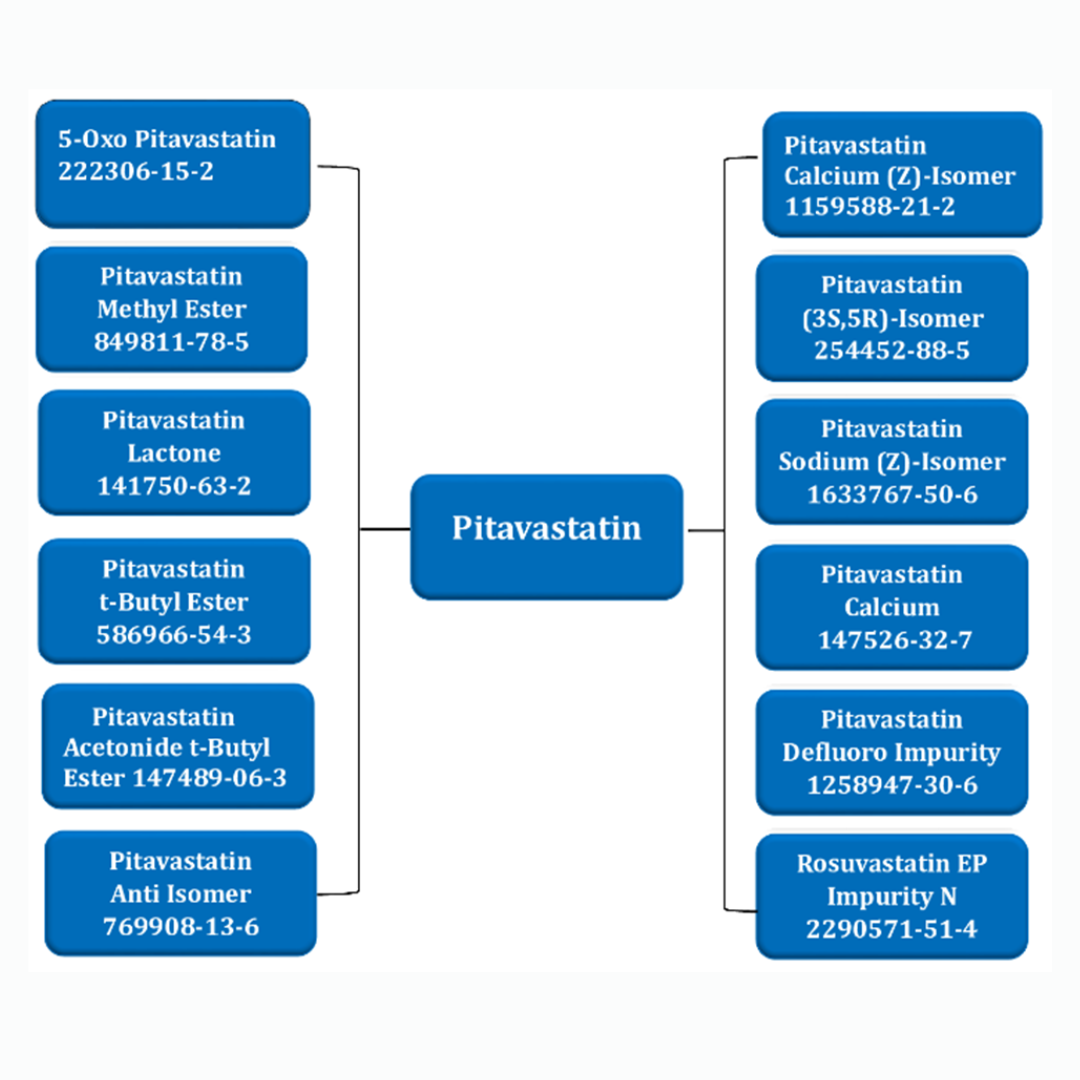
Comprehensive Guide to Pitavastatin Impurities: Ensuring Pharmaceutical Quality and Compliance
At Chemicea Pharmaceutical, we specialize in delivering high-quality pharmaceutical reference standards, including a comprehensive range of Pitavastatin impurities. These impurities are synthesized and characterized in compliance with international pharmacopeial guidelines such as the European Pharmacopoeia (EP), United States Pharmacopeia (USP), and other global standards.
Pitavastatin, a potent statin, plays a crucial role in managing cholesterol levels and reducing cardiovascular risks. Ensuring the purity, stability, and efficacy of Pitavastatin is essential, and the ability to identify and manage impurities is a key factor in maintaining product quality and regulatory compliance.
What Are Pitavastatin Impurities?
Pitavastatin impurities refer to substances that may form during the manufacturing, storage, or degradation of the drug. These impurities can affect the drug’s purity and efficacy. They must be identified, controlled, and minimized to meet pharmacopeial standards.
How Pitavastatin Impurities Impact Pharmaceutical Quality
Impurities in Pitavastatin can arise from several sources, such as synthesis by-products, degradation products due to environmental factors, or process inconsistencies. Proper identification and management of these impurities are vital for maintaining the drug’s quality, safety, and efficacy, ensuring compliance with EP, USP, and other regulatory standards.
Pitavastatin Chemical Details
- CAS Number: 147511-69-1
- Chemical Formula: C25H24FNO4
- Molecular Weight: 421.47 g/mol
- IUPAC Name: (3R,5S, E)-7-(2-Cyclopropyl-4-(4-fluorophenyl)quinolin-3-yl)-3,5-dihydroxyhept-6-enoic acid
- Synonyms:
- Livalo
- Zypitamag
- Pitava
These updated chemical details form the foundation for understanding Pitavastatin's synthesis, stability, and potential impurities, ensuring compliance with pharmacopeial standards.
Pitavastatin Structure

The Chemistry of Pitavastatin
Pitavastatin is an HMG-CoA reductase inhibitor that reduces cholesterol levels in the body. Its chemical structure includes a quinoline ring and a fluorophenyl group, making it highly effective in inhibiting cholesterol production. However, this complex structure also presents challenges in managing potential impurities during the drug's synthesis and storage.
Understanding the chemistry of Pitavastatin is key to identifying impurities and ensuring that the drug meets global regulatory guidelines.
Pharmaceutical Applications of Pitavastatin
- Primary Use: Pitavastatin is used to lower cholesterol and triglyceride levels, which helps prevent cardiovascular diseases such as heart attacks and strokes.
- Off-Label Uses: It has also been explored for its potential to reduce inflammation and treat lipid disorders.
The purity and stability of Pitavastatin are vital to its success in these applications. Controlling impurities ensures that Pitavastatin remains safe, effective, and compliant with global pharmacopeial standards.
Pitavastatin and Its Impurities Tree Diagram

Understanding Pitavastatin Impurities
Impurities in Pitavastatin can be classified into three main categories:
- Degradation Impurities: Formed when Pitavastatin is exposed to heat, light, or pH changes during storage.
- Process Impurities: By-products that result from incomplete reactions or side reactions during synthesis.
- Potential Impurities: Hypothetical impurities predicted based on the synthetic pathway and degradation mechanisms.
Managing these impurities is essential for maintaining the stability and efficacy of the drug. At Chemicea Pharmaceutical, we offer high-quality reference standards to help pharmaceutical companies ensure compliance with EP, USP, and global guidelines.
Key Pitavastatin Impurities Offered by Chemicea.
At Chemicea Pharmaceutical, we provide an extensive range of Pitavastatin impurities. These impurities are critical for quality control, stability testing, and method development in pharmaceutical research. Below is a list of key Pitavastatin impurities, arranged alphabetically:
|
CAT No. |
Impurity Name |
CAS Number |
These impurities are monitored and controlled to ensure product consistency and meet stringent regulatory standards, aiding pharmaceutical companies in achieving the highest quality for their products.
Classification and Description of Pitavastatin Impurities
5-Oxo Pitavastatin (CAS No. 222306-15-2)
- Type: Degradation Impurity
- Description: Forms as a result of oxidation during storage or processing.
- Role: Important in stability testing to assess oxidative stability.
Pitavastatin Calcium (Z)-Isomer (CAS No. 1159588-21-2)
- Type: Potential Impurity
- Description: Isomeric variation that may form during synthesis.
- Role: Monitored for method development and ensuring stereochemical consistency.
Pitavastatin Methyl Ester (CAS No. 849811-78-5)
- Type: Process Impurity
- Description: A by-product of esterification reactions.
- Role: Important for controlling synthesis parameters and ensuring product purity.
Pitavastatin (3S,5R)-Isomer (CAS No. 254452-88-5)
- Type: Process Impurity
- Description: Isomer formed during synthesis due to chiral inversion.
- Role: Ensuring enantiomeric purity is critical for pharmacological efficacy.
Pitavastatin Lactone (CAS No. 141750-63-2)
- Type: Degradation Impurity
- Description: Formed when Pitavastatin undergoes lactonization.
- Role: Used in stability testing to monitor hydrolytic stability.
Pitavastatin Sodium (Z)-Isomer (CAS No. 1633767-50-6)
- Type: Potential Impurity
- Description: Isomeric impurity associated with salt formation.
- Role: Important in method development and ensuring chemical consistency.
Pitavastatin t-Butyl Ester (CAS No. 586966-54-3)
- Type: Process Impurity
- Description: A synthetic intermediate that may persist in the final product.
- Role: Controlled to ensure product purity and compliance with pharmacopeial standards.
Pitavastatin Acetonide t-Butyl Ester (CAS No. 147489-06-3)
- Type: Process Impurity
- Description: Intermediate in synthesis pathways.
- Role: Important in controlling reaction conditions and optimizing yield.
Pitavastatin Defluoro Impurity (CAS No. 1258947-30-6)
- Type: Process Impurity
- Description: Results from defluorination reactions during synthesis.
- Role: Monitored for ensuring the purity of fluorinated derivatives.
Pitavastatin Anti Isomer (CAS No. 769908-13-6)
- Type: Potential Impurity
- Description: An isomer that can form through specific synthetic conditions.
- Role: Important for ensuring stereoisomeric purity.
How Chemicea Helps Ensure Quality
At Chemicea Pharmaceutical, we provide certified reference standards for Pitavastatin impurities, helping pharmaceutical companies maintain regulatory compliance and meet the highest quality standards. By utilizing our expertise in impurity profiling and synthesis, we ensure that your products are safe, effective, and fully compliant with international standards.
Conclusion and Call to Action
Managing Pitavastatin impurities is crucial for maintaining the quality, safety, and efficacy of pharmaceutical products. Chemicea Pharmaceutical provides the expertise and certified reference standards needed to support your quality control and regulatory compliance efforts.
For more information on our Pitavastatin impurities or to explore our comprehensive product catalog, contact our team today. We are committed to supporting your pharmaceutical development and ensuring your products meet the highest industry standards.